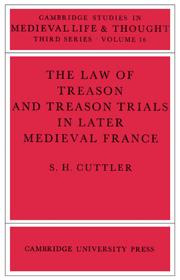Book contents
- Frontmatter
- Contents
- Dedication
- Preface
- Abbreviations
- Introduction
- 1 THE CONCEPT OF TREASON IN LATER MEDIEVAL FRANCE: LEGISTS, ‘COUTUMIERS’ AND TREATISE-WRITERS
- 2 THE CRIMES OF TREASON
- 3 JURISDICTION
- 4 PROCEDURE AND THE TRIAL OF PEERS
- 5 PUNISHMENT, FORFEITURE AND PARDON
- 6 TREASON AND THE CROWN 1328–1356
- 7 TREASON AND THE CROWN 1356–1380
- 8 TREASON AND THE CROWN 1380–1422
- 9 TREASON AND THE CROWN 1422–1461
- 10 TREASON AND THE CROWN 1461–1494
- Conclusion
- Bibliography
- Index
7 - TREASON AND THE CROWN 1356–1380
Published online by Cambridge University Press: 13 October 2009
- Frontmatter
- Contents
- Dedication
- Preface
- Abbreviations
- Introduction
- 1 THE CONCEPT OF TREASON IN LATER MEDIEVAL FRANCE: LEGISTS, ‘COUTUMIERS’ AND TREATISE-WRITERS
- 2 THE CRIMES OF TREASON
- 3 JURISDICTION
- 4 PROCEDURE AND THE TRIAL OF PEERS
- 5 PUNISHMENT, FORFEITURE AND PARDON
- 6 TREASON AND THE CROWN 1328–1356
- 7 TREASON AND THE CROWN 1356–1380
- 8 TREASON AND THE CROWN 1380–1422
- 9 TREASON AND THE CROWN 1422–1461
- 10 TREASON AND THE CROWN 1461–1494
- Conclusion
- Bibliography
- Index
Summary
With Jean II in captivity France plunged into anarchy. In spite of the two-year truce signed at Bordeaux in March 1357, the war continued, particularly against the Navarrese in Normandy. Free-booting soldiers devastated the countryside everywhere. A constitutional crisis threatened the very nature of the French monarchy. Politically weak, unsure of himself, in want of both troops and money, the eighteen-year-old dauphin Charles floundered in this sea of troubles. One indication of this was that in his first twenty-three months as royal lieutenant and then as regent, he took little action to stem the tide of treason.
The dauphin's weakness at this time is exemplified by his relations with the king of Navarre. On the night of 8–9 November 1357 Navarre had been freed from his imprisonment in the castle of Arleux in Picardy by Jean de Picquigny. Immediately he made for Amiens, where he stayed with the canon Gui Quiéret. On 29 November, having received a safe-conduct from the dauphin which was taken to him by Mathieu de Picquigny and Charles Toussac, Navarre entered Paris. The strong support for Charles the Bad among the burgesses of Paris; the adverse course of the hostilities; and Navarre's virtual stranglehold on Paris forced the dauphin to yield. On 12 December 1357 he and Navarre reached an accord. Among the terms were provisions for Navarre and his adherents, including Jean de Picquigny, to receive pardons and restitution of their property; for the remains of Harcourt and the others executed at Rouen in April 1356 to be taken down from the gibbet and given solemn burial; and for their property to be restored to their heirs. On 8 January 1358 Navarre arrived in Rouen.
- Type
- Chapter
- Information
- The Law of Treason and Treason Trials in Later Medieval France , pp. 163 - 180Publisher: Cambridge University PressPrint publication year: 1982



